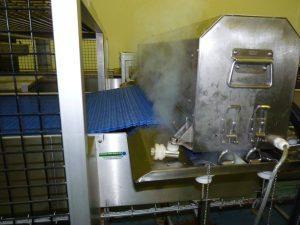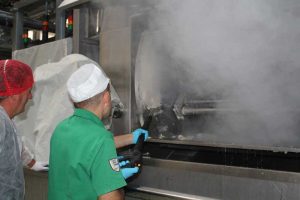In the realm of industrial operations, conveyor systems serve as the backbone for transporting materials efficiently. However, the effectiveness of these systems can be significantly compromised by the accumulation of debris and material spillage on the conveyor belt. This is where belt cleaners come into play.
These essential components are designed to remove residual material from the belt’s surface, ensuring that it operates smoothly and effectively. By maintaining a clean belt, you not only enhance the performance of the conveyor system but also prolong its lifespan, reducing the need for costly repairs and replacements. Belt cleaners come in various designs and configurations, tailored to meet the specific needs of different industries and applications.
Whether you are dealing with heavy-duty mining operations or light manufacturing processes, there is a belt cleaner suited to your requirements. These devices work by scraping or brushing the belt surface, dislodging any material that may have adhered during transport. As you consider the role of belt cleaners, it becomes clear that they are not merely accessories; they are vital components that contribute to the overall efficiency and reliability of conveyor systems.
Summary
- Belt cleaners play a crucial role in conveyor systems by removing carryback and preventing material buildup, which can cause damage and inefficiency.
- Effective belt cleaners can significantly improve productivity and efficiency by reducing downtime for cleaning and maintenance, and by preventing material spillage and loss.
- Belt cleaners are essential for maintaining workplace safety by reducing the risk of slip and fall accidents, fire hazards, and equipment damage.
- Choosing the right belt cleaner for your conveyor system involves considering factors such as belt type, material characteristics, and operating conditions.
- Effective belt cleaners can lead to cost savings through reduced maintenance, increased equipment lifespan, and improved environmental compliance.
The Impact of Belt Cleaners on Productivity and Efficiency
Optimising Conveyor Belt Performance
The presence of effective belt cleaners can have a profound impact on productivity and efficiency within your operations. When a conveyor belt is clean, it operates at optimal performance levels, reducing the likelihood of unexpected downtime caused by blockages or material build-up. This means that your production line can run smoothly, allowing you to meet deadlines and fulfil orders without interruption.
Maintaining Continuous Operation
In industries where time is money, the role of belt cleaners in maintaining continuous operation cannot be overstated. Moreover, clean belts contribute to improved energy efficiency. When material accumulates on the belt, it can create additional friction, leading to increased energy consumption as motors work harder to move the load.
Reducing Energy Costs and Enhancing Sustainability
By investing in high-quality belt cleaners, you can reduce this friction and lower your energy costs. This not only enhances your bottom line but also supports sustainability efforts by minimising energy waste. In essence, effective belt cleaning translates directly into enhanced productivity and operational efficiency.
The Importance of Belt Cleaners in Maintaining Workplace Safety

Workplace safety is a paramount concern in any industrial setting, and belt cleaners play a crucial role in ensuring a safe working environment. Accumulated materials on conveyor belts can pose significant hazards, including slips, trips, and falls for employees working in proximity to these systems. By keeping belts clean, you mitigate these risks and create a safer workplace for your staff.
This is particularly important in environments where heavy machinery is in operation, as even minor accidents can lead to serious injuries. Furthermore, effective belt cleaning helps prevent equipment malfunctions that could lead to accidents. When debris builds up on a conveyor system, it can cause misalignment or damage to other components, potentially resulting in catastrophic failures.
By prioritising regular cleaning and maintenance through the use of reliable belt cleaners, you not only protect your employees but also safeguard your equipment and investments. In this way, belt cleaners contribute significantly to fostering a culture of safety within your organisation.
Choosing the Right Belt Cleaner for Your Conveyor System
| Factors to Consider | Importance |
|---|---|
| Type of Material Being Conveyed | High |
| Belt Speed | High |
| Belt Width | Medium |
| Head Pulley Size | Medium |
| Tension and Cleanliness of the Belt | High |
| Environmental Conditions | Medium |
Selecting the appropriate belt cleaner for your conveyor system is a critical decision that can influence both performance and maintenance requirements. There are several factors to consider when making this choice, including the type of material being transported, the operating environment, and the specific challenges you face with material build-up. For instance, if you are dealing with sticky or abrasive materials, you may require a more robust cleaning solution than if you are transporting dry powders.
It is also essential to consider the design of your conveyor system itself. Different configurations may necessitate specific types of cleaners to ensure effective operation. For example, some systems may benefit from primary cleaners that remove bulk material, while secondary cleaners can be employed for finer residue removal.
Consulting with manufacturers or industry experts can provide valuable insights into which products will best suit your needs. Ultimately, investing time in selecting the right belt cleaner will pay dividends in terms of performance and longevity.
The Cost-Saving Benefits of Effective Belt Cleaners
While there may be an initial investment associated with purchasing high-quality belt cleaners, the long-term cost-saving benefits are substantial. By preventing material build-up and ensuring that your conveyor system operates efficiently, you can significantly reduce maintenance costs over time. Regular cleaning helps avoid wear and tear on both the belts and associated machinery, leading to fewer repairs and replacements.
This proactive approach not only saves money but also minimises operational disruptions that can arise from unexpected equipment failures. Additionally, effective belt cleaning contributes to lower energy costs by reducing friction and improving overall system efficiency. As mentioned earlier, when belts are clean, they require less energy to operate, which can lead to significant savings on utility bills.
Over time, these savings can accumulate, making a compelling case for investing in quality belt cleaning solutions. In essence, effective belt cleaners are not just an expense; they are an investment in the future efficiency and profitability of your operations.
The Environmental Impact of Proper Belt Cleaning

Reducing Waste and Contamination Risks
Proper belt cleaning practices can have a positive impact on your organisation’s environmental footprint. By ensuring that materials do not spill or accumulate outside designated areas, you reduce waste and minimise contamination risks.
Minimising Environmental Damage and Regulatory Penalties
This is particularly crucial in industries where hazardous materials are involved, as spills can lead to significant environmental damage and regulatory penalties. Moreover, effective belt cleaning contributes to sustainability efforts by promoting resource efficiency. When materials are kept on the conveyor belt rather than being lost to spillage or contamination, you maximise the use of resources and reduce waste generation.
Enhancing Brand Reputation and Corporate Social Responsibility
This not only benefits your bottom line but also aligns with broader corporate social responsibility goals. By prioritising proper belt cleaning practices, you demonstrate a commitment to environmental stewardship that can enhance your brand reputation and appeal to environmentally conscious consumers.
Maintenance and Best Practices for Belt Cleaners
To ensure that your belt cleaners operate effectively over time, regular maintenance is essential. This includes routine inspections to identify wear and tear on cleaning blades or brushes and replacing them as necessary. Additionally, keeping the surrounding area clean and free from debris will help maintain optimal performance levels for your belt cleaning systems.
Establishing a maintenance schedule can help you stay ahead of potential issues before they escalate into costly problems. Best practices also involve training your staff on the importance of proper belt cleaning procedures. Ensuring that employees understand how to operate and maintain these systems will contribute to their longevity and effectiveness.
Encouraging a culture of cleanliness within your organisation will not only enhance operational efficiency but also promote safety among your workforce. By prioritising maintenance and best practices for belt cleaners, you set the stage for sustained success in your operations.
Innovations and Advancements in Belt Cleaner Technology
As technology continues to evolve, so too do the innovations in belt cleaner design and functionality. Recent advancements have led to the development of more efficient cleaning systems that utilise advanced materials and engineering techniques to enhance performance. For instance, some modern belt cleaners feature adjustable blade angles that allow for more effective contact with the belt surface, improving cleaning efficiency while reducing wear on both the cleaner and the belt itself.
Additionally, smart technology is making its way into belt cleaning systems, enabling real-time monitoring and data collection on performance metrics. This allows for predictive maintenance strategies that can identify potential issues before they become significant problems. By embracing these innovations, you can ensure that your conveyor systems remain at the forefront of efficiency and reliability.
As you look towards the future of industrial operations, staying informed about advancements in belt cleaner technology will be key to maintaining a competitive edge in your industry.
FAQs
What is a belt cleaner?
A belt cleaner is a tool used to remove material adhering to the surface of a conveyor belt. It helps to maintain the cleanliness of the belt and prevent material buildup, which can lead to belt damage and reduced efficiency.
Why is a belt cleaner important?
A belt cleaner is important because it helps to ensure the smooth operation of conveyor systems by preventing material buildup and reducing the risk of belt damage. It also helps to maintain a clean working environment and improve overall safety.
How does a belt cleaner work?
A belt cleaner typically consists of a blade or brush that comes into contact with the conveyor belt, effectively scraping or brushing off any material that has adhered to the belt surface. This helps to keep the belt clean and free from debris.
What are the different types of belt cleaners?
There are several types of belt cleaners, including primary cleaners, secondary cleaners, and specialty cleaners. Primary cleaners are positioned at the head pulley and are the first line of defense against material buildup. Secondary cleaners are positioned further along the belt and provide additional cleaning. Specialty cleaners are designed for specific applications or challenging materials.
How do I choose the right belt cleaner for my application?
When choosing a belt cleaner, it’s important to consider factors such as the type of material being conveyed, the belt speed, the conveyor system layout, and any specific challenges or requirements of the application. Consulting with a belt cleaning specialist can help in selecting the most suitable belt cleaner for a particular application.










